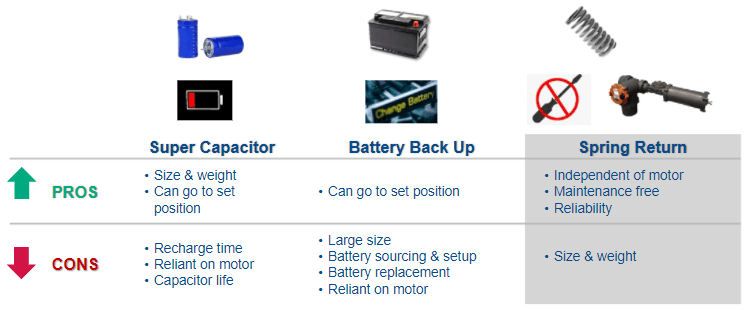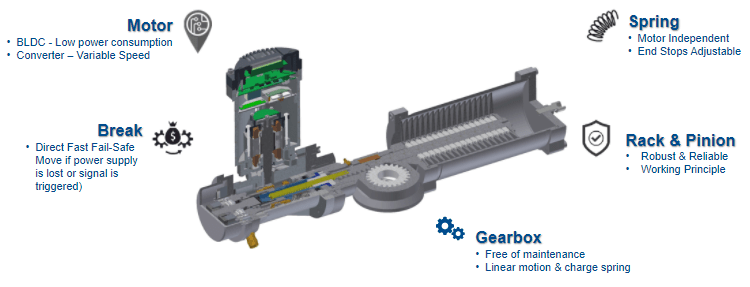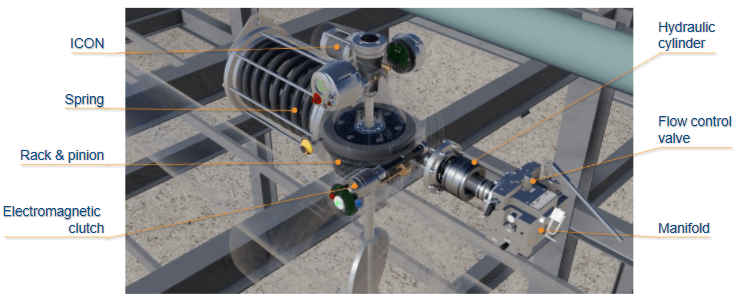Valves used in safety shutdown applications require actuators to perform reliably on demand. In a recorded webinar, Smart Electric Valve Actuators for Critical Fail-Safe Applications, Emerson’s Knut Riegel and Umberto Bianchi share how these actuators are well-suited for emergency shutdown (ESD) applications.
Knut provides background on ESD valves and their use and addresses the question on if ESD valve applications always require a fluid-powered actuator. After addressing this question, he shares how to move to the fail-safe position with an electric actuator and the working principle behind the Bettis RTS Series fail-safe electric actuators. He explains how these actuators can achieve the necessary safety integrity level (SIL) requirements for the safety instrumented function.
Umberto shares the main advantages in using the Biffi EFS electric quarter-turn, smart fail-safe actuators for opening and closing valves per the required safety demand.
ESD valves are always actuated and designed to stop the fluid flow in a fail-safe manner upon detection of a dangerous event. These valves are commonly found in hazardous applications in upstream, midstream and downstream hydrocarbon-based processes as well as others with hazardous processes.
Fluid-powered actuators require compressed air or hydraulic fluid and require supply pressure, space dependent on the torque requirements of the ESD valve, and considerations for digital communication connections for preventive and predictive maintenance.
Knut shared 3 methods for moving ESD valves to fail-safe positions with electric actuators—super capacitors, battery backup, and spring return.
He shared how the spring return method’s reliability is the main reason this fail-safe method is used in the Bettis RTS actuator. Here is a diagram of how this actuator works and provides fail-safe operation.
Watch the recorded webinar for more on Knut’s explanation of how this operates, how they achieve the required risk mitigation for the SIL application, and ways to simplify ongoing maintenance through desktop and mobile applications. One ESD valve with the Bettis RTS actuator can be applied in up to SIL level 2 applications, and 2 ESD valves in series with these actuators can be applied for SIL 3 applications.
Umberto described how the Biffi EFS quarter-turn actuator is also failsafe and supports greater torque requirements up to 9000 Newton-meters (Nm) [6638 ft-lbs.] The working principle is also based on a smart fail-safe spring return design.
Umberto shared some case studies including a liquefied petroleum gas (LPG) storage and transport facility which used the Biffi EFS actuators on their ESD valves as part of their safety instrumented system. He cited other processes where these actuators were installed in applications up to SIL 3 including gas compressor stations, tank farms and other hazardous processes. These actuators support a wide range of digital communication technologies including Foundation fieldbus, Profibus, HART, LonWorks and Modbus as well as diagnostic software for setup, operation and maintenance.
Watch the webinar for more and questions that Knut and Umberto addressed. Visit the Actuators section on Emerson.com for more on the quarter-turn and multi-turn Bettis and Biffi electric actuators to handle your toughest safety applications. You can also connect and interact with other actuator experts in the Valves, Actuators & Regulators group in the Emerson Exchange 365 community.









